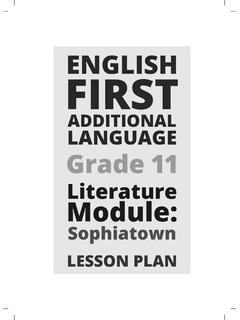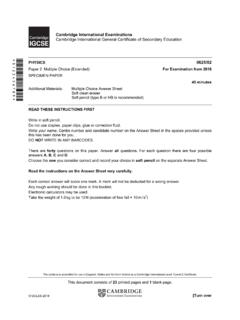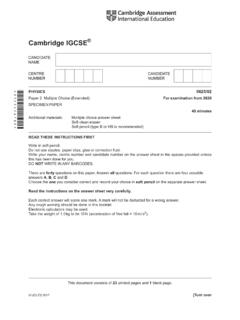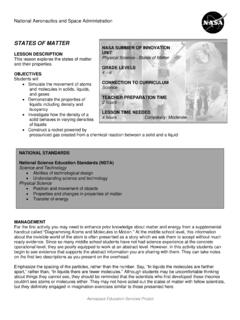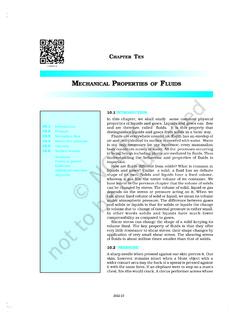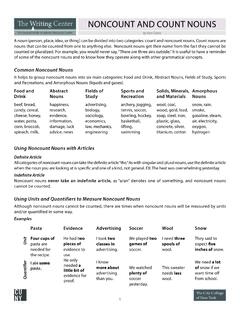Transcription of NATURAL SCIENCES TECHNOLOGY - National Education …
1 Interesting Science fact #1 Sphenopalatine ganglioneuralgia is the scientific term for brain TECHNOLOGYLESSON PLANGRADE 4 TERM 223 Grade 4 NATURAL SCIENCES & TECHNOLOGY Term 2 Grade 4 NATURAL SCIENCES & TECHNOLOGY Term 2 National Education COLLABORATION TRUST (NECT)Dear TeachersThis learning programme and training is provided by the National Education Collaboration Trust (NECT) on behalf of the Department of Basic Education (DBE)! We hope that this programme provides you with additional skills, methodologies and content knowledge that you can use to teach your learners more effectively. What is NECT?In 2012 our government launched the National Development Plan (NDP) as a way to eliminate poverty and reduce inequality by the year 2030. Improving Education is an important goal in the NDP which states that 90% of learners will pass Maths, Science and languages with at least 50% by 2030. This is a very ambitious goal for the DBE to achieve on its own, so the NECT was established in 2015 to assist in improving Education .
2 The NECT has successfully brought together groups of people interested in Education to work together to improve Education . These groups include the teacher unions, businesses, religious groups, trusts, foundations and are the learning programmes?One of the programmes that the NECT implements on behalf of the DBE is the District Development Programme . This programme works directly with district officials, principals, teachers, parents and learners; you are all part of this programme! The programme began in 2015 with a small group of schools called the Fresh Start Schools (FSS). Curriculum learning programmes were developed for Maths, Science and Language teachers in FSS who received training and support on their implementation. The FSS teachers remain part of the programme, and we encourage them to mentor and share their experience with other teachers. The FSS helped the DBE trial the NECT learning programmes so that they could be improved and used by many more teachers.
3 NECT has already begun this scale-up process. NECT has already begun this scale-up process in its Universalisation Programme and in its Provincialisation Programme. Everyone using the learning programmes comes from one of these groups; but you are now brought together in the spirit of collaboration that defines the manner in which the NECT works. Teachers with more experience using the learning programmes will deepen their knowledge and understanding, while some teachers will be experiencing the learning programmes for the first time. Let s work together constructively in the spirit of collaboration so that we can help South Africa eliminate poverty and improve Education ! A MESSAGE FROM THE NECT23 Grade 4 NATURAL SCIENCES & TECHNOLOGY Term 2 Grade 4 NATURAL SCIENCES & TECHNOLOGY Term 2 CONTENTSPROGRAMME ORIENTATION4 CAPS AND THE LESSON PLANS8 TOPIC OVERVIEW MATERIALS AROUND US 1A - 3B15-17 Week 1 Lesson 1 ASOLIDS.
4 LIQUIDS AND GASES18 Week 1 Lesson 1 BSOLIDS22 Week 1 Lesson 1 CLIQUIDS27 Week 2 Lesson 2 AGASES32 Week 2 Lesson 2 BCHANGING THE STATE OF MATERIALS37 Week 2 Lesson 2 CHEATING MATERIALS41 Week 3 Lesson 3 ACOOLING MATERIALS46 Week 3 Lesson 3 BTHE WATER CYCLE51 TOPIC OVERVIEW solid MATERIAL 3B - 5B56-58 Week 3 Lesson 3 CRAW AND MANUFACTURED MATERIALS59 Week 4 Lesson 4 ASAND AND CLAY63 Week 4 Lesson 4 BCOAL AND OIL68 Week 4 Lesson 4 CPAPER MAKING73 Week 5 Lesson 5 AANIMAL WOOL AND HIDE78 Week 5 Lesson 5 BPROPERTIES OF MATERIALS83 TOPIC OVERVIEW STRENGTHENING MATERIALS 5C - 6B88-89 Week 5 Lesson 5 CSTRENGTHENING MATERIALS90 Week 6 Lesson 6 AHOLLOW PAPER PILLARS95 Week 6 Lesson 6 BMAKING STRUTS100 TOPIC OVERVIEW STRONG FRAME STRUCTURES 6C - 8C104-105 Week 6 Lesson 6 CSTRUT AND FRAME STRUCTURES106 Week 7 Lesson 7 AJOINING STRUTS111 Week 7 Lesson 7 BINDIGENOUS STRUCTURES115 Week 7 Lesson 7 CINVESTIGATING WATER TOWERS120 Week 8 Lesson 8 ADESIGNING A WATER TOWER125 Week 8 Lesson 8 BMAKING A WATER TOWER131 Week 8 Lesson 8 CEVALUATING A WATER TOWER136 GRADE 4 ASSESSMENT140 Term 2 ASSESSMENT142 Term 2 PRACTICAL TASK - INTRODUCTION145 Term 2 PRACTICAL TASK - MEMORANDUM146 Term 2 TERM EXAM148 Term 2 MEMORANDUM15545 Grade 4 NATURAL SCIENCES & TECHNOLOGY Term 2 Grade 4 NATURAL SCIENCES & TECHNOLOGY Term 2 Welcome to the NECT NATURAL SCIENCES & TECHNOLOGY learning programme!
5 This CAPS compliant programme consists of: A full set of lesson plans for the term (3 lessons per week) A resource pack with images to support the lesson plans A full colour poster for one topic An outline of the assessment requirements for the term A tracker to help you monitor your progressLesson Plan Structure1. The Term 1 lesson plan is structured to run for 8 weeks. 2. Each week, there are three lessons, of the following notional time:1 x 1 hour 30 minutes2 x 1 hourThis time allocation of hours per week is CAPS aligned. Lesson Plan Contents1. The lesson plan starts with a CONTENTS PAGE that lists all the topics for the term, together with a breakdown of the lessons for that topic. You will notice that lessons are named by the week and lesson number, for example, Week 8 Lesson 8C. 2. Every topic begins with a 2 - 4 page TOPIC OVERVIEW. The topic overview pages are grey, making them easy to identify.
6 The topic overview can be used to introduce the topic to learners. The topic overview includes:a. A general introduction to the topic that states how long the topic runs for, the value of the topic in the final exam and the number of lessons in the topic. b. A table showing the position of the topic in the term. c. A sequential table that shows the prior knowledge required for this topic, the current knowledge and skills that will be covered, and how this topic will be built on in future years. Use this table to give learners an informal quiz to test their prior knowledge. If learners are clearly lacking in the knowledge and skills required, you may need to take a lesson to cover some of the essential content and skills. It is also useful to see what you are preparing learners for next, by closely examining the looking forward column. d. A glossary of scientific and technological vocabulary, together with an explanation of each word or phrase.
7 It is a good idea to display these words and their definitions somewhere in the classroom, for the duration of the topic. It is also a good idea to allow learners some time to copy down these words into their personal dictionaries or science exercise books. You must explicitly teach the words and their meanings as and when you encounter these words in the topic. A good way to teach learners new vocabulary is to use PATS :PROGRAMME ORIENTATION45 Grade 4 NATURAL SCIENCES & TECHNOLOGY Term 2 Grade 4 NATURAL SCIENCES & TECHNOLOGY Term 2 PROGRAMME ORIENTATIONo POINT if the word is a noun, point at the object or at a picture of the object as you say the ACT if the word is a verb, try to act out or gesture to explain the meaning of the word, as you say TELL if the word has a more abstract meaning, then tell the learners the meaning of the word. You may need to code switch at this point, but also try to provide a simple English SAY say the word in a sentence to reinforce the meaning.
8 E. Understanding the uses / value of NATURAL SCIENCES & TECHNOLOGY . It is very important to give learners a sense of how science applies to their daily lives, and of the value that science adds to their lives. Hold a brief discussion on this point when introducing the topic, and invite learners to elaborate on the uses and value that this topic will have to their lives. f. Personal reflection. At the end of every topic, come back to the topic overview, and complete this table. In particular, it is important to note your challenges and ideas for future improvement, so that you can improve your teaching the next year. 3. After the topic overview, you will find the INDIVIDUAL LESSONS. Every lesson is structured in exactly the same way. This helps you and the learners to anticipate what is coming next, so that you can focus on the content and skills. Together with the title, each lesson plan includes the following:a.
9 Policy and Outcomes. This provides you with the CAPS reference, and an overview of the skills that will be covered in the lesson. You can immediately see the SCIENCE PROCESS AND DESIGN SKILLS that will be covered, and whether they are lower or higher order skills. b. Possible Resources. Here, you will see the resources that you should ideally have for the lesson. If you need to use the poster or pages from the resource pack, this will be listed here. There is also a space for improvised resources, and you are invited to add your own ideas Classroom Management. Every lesson starts in the same way. Before the lesson, you must write a question that relates to the previous lesson on the chalkboard. Train your learners to come in to the classroom, to take out their exercise books, and to immediately try to answer this question. This links your lesson to the previous lesson, and it effectively settles your learners.
10 Once learners have had a few minutes to answer, read the question and discuss the answer. You may want to offer a small reward to the learner who answers first, or best. Get your learners used to this routine. Next, make sure that you are ready to begin your lesson, have all your resources ready, have notes written up on the chalkboard, and be fully prepared to start. Remember, learners will get restless and misbehave if you do not keep them busy and focussed. d. Accessing Information. This section contains the key content that you need to share with learners. Generally, it involves sharing some new information that is written on the chalkboard, explaining this information, and allowing learners some time to copy the information into their exercise books. Train learners to do this quickly and efficiently. Learners must anticipate this part of the lesson, and must have their books, pens, pencils and rulers ready.


